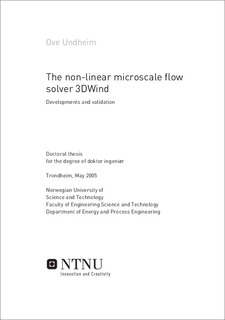The Non-Linear Microscale Flow Solver 3DWind. Developments and Validation
Doctoral thesis
Permanent lenke
http://hdl.handle.net/11250/233365Utgivelsesdato
2005Metadata
Vis full innførselSamlinger
Sammendrag
This PhD thesis describes the implementation of a Reynolds Stress Model in the RANS microscale solver 3DWind, which is developed to model wind flow in complex terrain. The solver is also calibrated and validated with the two-dimensional channel flow test case C18 from the ERCOFTAC Classic database and the full-scale atmospheric flow case of the Askervein hill.
The implemented equations calculate both flow cases in good accordance with available experimental and numerical results. Still, the simulation experience and obtained results show that modelling of recirculation is a difficult task. The calculated flow field is very sensitive to the separation point, which is sensitive to several other factors. One important factor is the wall functions, which cause the separation zone to depend on the thickness of the first grid cell.
Compared to the k-ε model, results from simulations with the Reynolds Stress Model gave improvements in the calculated turbulence upstream the C18 hill. There were also differences in the solutions in the wake of both the C18 and the Askervein hills; still, the differences are too small to make any conclusions about the quality of the models. The disadvantages of decreased stability, more wiggles in the solution and increased computational effort are considered larger than the advantages of accounting for anisotropy and historical effects in the Reynolds stresses.
The solver is further used to quantify the effects of roughness and topography by generalized two-dimensional investigations of atmospheric flow. Hills and ridges are in this analysis found to increase wind velocities at 80m by up to 38%, and wind velocities above the ocean at 80m are 14% higher than corresponding open land velocities. Finally, a full wind resource assessment has been carried out at Eldsfjellet at the Norwegian island Hitra. Results were compared with measured data and simulation results from the linearized model WAsP. WAsP was found to estimate higher velocities in the valleys and near terrain edges, and WAsP is supposed to overestimate the velocities in these areas.
Består av
Undheim, O. Description and validation of 3DWind. .Undheim, O; Andersson, H.I; Berge, E. Non-Linear, Microscale Modelling of the Flow Over Askervein Hill. Boundary-Layer Meteorology. 120(3): 477-495, 2006.
